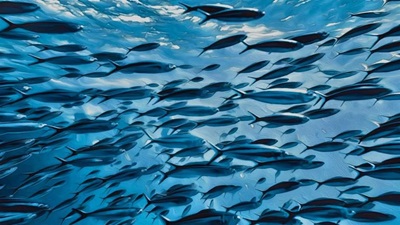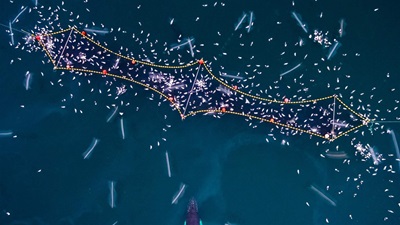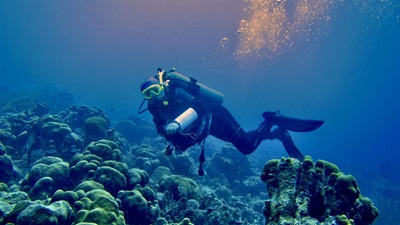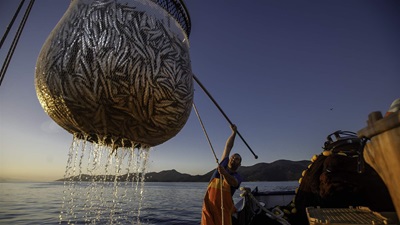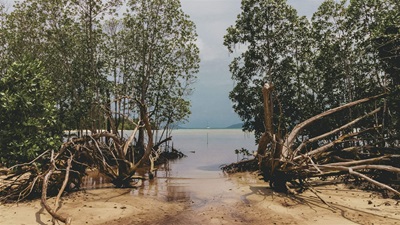Marine Biologist Aims to Rebuild Hong Kong’s Lost Pearl Oyster Reefs
Dr. James Kar-Hei Fang leads effort to reconnect with region’s marine heritage

For centuries, pearl oysters played a role in Hong Kong’s culture, economy, and marine ecosystems—important not only for improving water quality and providing habitats for various marine species, but also for supporting the region’s thriving pearl industry. But a combination of overharvesting, pollution, and coastal development eventually led to the degradation and disappearance of oyster reefs in Hong Kong’s waters.
Dr. James Kar-Hei Fang, a 2024 Pew marine fellow and associate professor at The Hong Kong Polytechnic University, is working to bring the valuable bivalves back to Hong Kong’s waters. By using oysters cultured in captivity and collaborating with local fishers along the Tolo Channel in northeastern Hong Kong, Fang hopes to both restore pearl oyster reefs and revive a lost piece of the region’s heritage.
This interview with Fang has been edited for clarity and length.
What inspired you to pursue this project?
Growing up in Hong Kong, I was always captivated by its rich biodiversity thriving in the water alongside densely developed urban landscape. Learning about the historical abundance of pearl oysters in Hong Kong and their role in supporting ecosystems and the livelihoods of local communities inspired me to explore how we could bring them back.
What has your research shown so far?
Preliminary studies show that Hong Kong’s waters still support pearl oyster larvae, confirming their potential for restoration. Our pilot deployment of pearl oysters has attracted small fish and invertebrates, offering encouraging evidence of potential ecological benefits.
What role do oyster reefs play in supporting coastal ecosystems?
Oyster reefs—including those formed when pearl oysters attach themselves to hard surfaces such as rocks and begin to grow together over time—are ecological powerhouses. They improve water quality by filter-feeding, which removes excess nutrients from the water, and the complex underwater structures they form provide habitats and shelters for fish and other marine species, which helps boost biodiversity. Oyster reefs also act as natural breakwaters—structures along coastlines that help to protect the shore or harbors from coastal erosion.
Historically, Hong Kong’s pearl oyster reefs also played a vital role in sustaining fisheries and pearl production, so their restoration is a key step toward reviving marine health.
And what would you say is the cultural significance of pearl oysters in Hong Kong?
Pearl oysters have deep cultural and economic ties to Hong Kong. The region was once renowned for its pearl fisheries—which thrived in the clean, nutrient-rich waters—and pearl fishing served as one of the population’s main economic activities for centuries. However, overharvesting and pollution led to the collapse of the oyster stocks in the 17th century.
By focusing on pearl oysters, we’re not just restoring an ecologically important species but reviving a piece of Hong Kong’s heritage. Their return could also pave the way for sustainable pearl farming, benefiting local fishers and artisans.
So how do you plan to restore these pearl oyster reefs?
Rebuilding a pearl oyster reef begins with selecting a suitable site, like Hong Kong’s Tolo Channel, where improved water quality can now support the growth of pearl oysters. After that, we cultivate baby pearl oysters in hatcheries and then transplant them onto natural substrates, or 3D-printed artificial reef structures, in the channel.
How will you measure the impact of this restoration work?
We’ll continuously monitor the pearl oysters’ health and track their ecosystem impacts through 3D technologies and environmental DNA analysis. We’ll use biodiversity surveys to track changes in fish and invertebrate communities, and other marine species attracted to the reefs. Water quality tests will help us measure factors like turbidity, nutrient levels, and pollutants to evaluate the oysters’ filtering effects. And we’ll use tools such as 3D scanning and photogrammetry to measure how reefs grow and change over time.
Overall, these approaches will give us a multidimensional understanding of how pearl oyster restoration influences marine ecosystem health.
Are there any special considerations for undertaking this work in an urban setting like Hong Kong?
Yes, Hong Kong’s marine environment faces unique challenges, including heavy shipping traffic, pollution, and limited space for restoration. We must carefully select sites that are less affected than others by human activities, and we have to work closely with government agencies to ensure compliance with regulations.
Public engagement is equally vital. By showing local communities firsthand how pearl oysters purify water, enhance fisheries, and sustain coastal economies, we can inspire them to become active partners in conservation.
How exactly do you plan to engage these local communities?
We’re collaborating closely with local fishers to implement sustainable aquaculture, or fish farming, practices. And through hands-on workshops we plan to train fishers in pearl harvesting techniques, while developing market pathways for responsibly produced pearls. By involving the fishers from the start, we hope the project will support both ecological restoration and local livelihoods.
Speaking of hope: What do you hope ultimately comes from your research?
Beyond ecological restoration, our goal is to develop a framework for urban marine conservation that balances both environmental and community needs. Success would mean the creation of self-sustaining pearl oyster reefs, improved marine biodiversity, and a revived pearl industry that supports local livelihoods. Ultimately, we hope this approach can inspire similar projects in other coastal urban areas.




